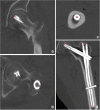Effect of reduction quality on post-operative outcomes in 31-A2 intertrochanteric fractures following intramedullary fixation: a retrospective study based on computerised tomography findings
- PMID: 30116869
- PMCID: PMC6647079
- DOI: 10.1007/s00264-018-4098-1
Effect of reduction quality on post-operative outcomes in 31-A2 intertrochanteric fractures following intramedullary fixation: a retrospective study based on computerised tomography findings
Abstract
Purpose: To determine how the reduction of medial and anteromedial cortices using CT findings in 31-A2 intertrochanteric fractures treated with the intramedullary nail could affect the clinical outcomes and complication rates of the fractures.
Methods: We retrospectively analyzed the data of 43 patients with 31-A2 intertrochanteric fractures who underwent closed reduction and intramedullary internal fixation (CRIF) between January 2010 and December 2013. Patients were classified into two groups based on the post-operative CT scans taken from the sagittal and coronal planes, respectively. Five radiographic parameters and three clinical parameters were used to evaluate the post-operative functional states and mobilization levels in this study. Post-operative complications were also recorded.
Results: The mean loss of the femoral neck-shaft angle (FNSA) was significantly smaller in Group C1 than that in Group C2. There were significant differences in the sliding distance of the cephalic nail and the loss of femoral head height between the two groups. In terms of the reduction conditions shown on the sagittal planes, the FNSA, sliding distance of the cephalic nail, and the loss of FHH were significantly different, although differences in TCD were not significant. Patients in groups C1 (3.6%) and S1 (0.0%) had lower complication rates compared to patients in groups C2 (26.7%) and S2 (27.8%).
Conclusion: Patients with good reduction quality of the medial and anteromedial sustainable cortices had better clinical outcomes and lower complication rates. The sustainable stability and anti-rotational function of these validated reductions might play a critical role in maintaining the fragment positions and reducing the incidence of complications in patients.
Keywords: CT findings; Intertrochanteric fractures; Intramedullary nail; Outcomes; Reduction quality.
Conflict of interest statement
The authors declare that they have no competing interests.
Figures





References
-
- Lizaur-Utrilla A, Gonzalez-Navarro B, Vizcaya-Moreno MF, Miralles Munoz FA, Gonzalez-Parreno S, Lopez-Prats FA (2018) Reasons for delaying surgery following hip fractures and its impact on one year mortality. Int Orthop. 10.1007/s00264-018-3936-5 - PubMed
Publication types
MeSH terms
LinkOut - more resources
Full Text Sources
Other Literature Sources
Medical
Molecular Biology Databases
Miscellaneous

